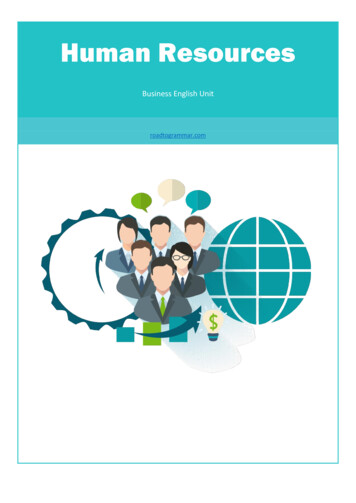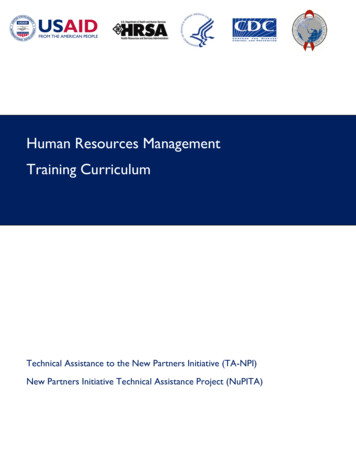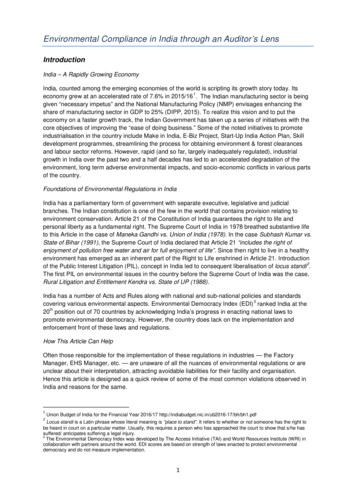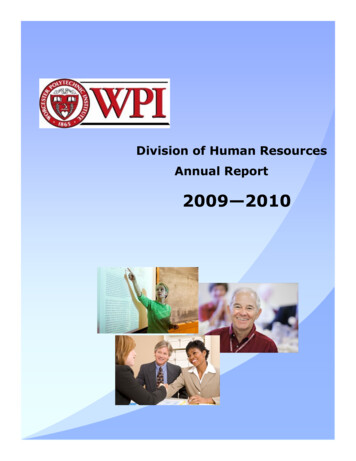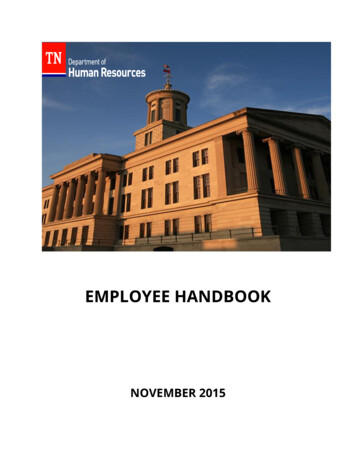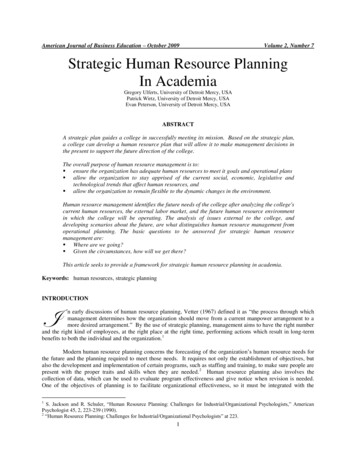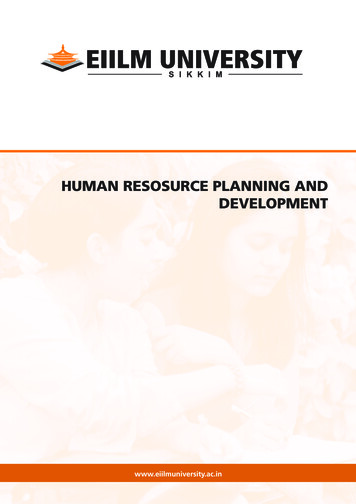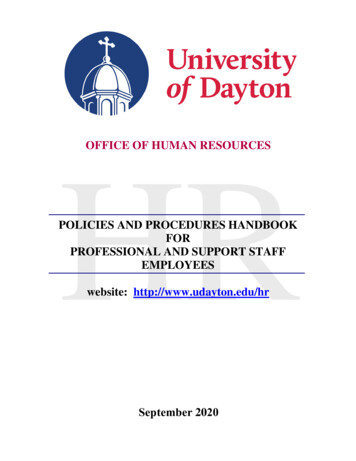
Transcription
OFFICE OF HUMAN RESOURCESHRPOLICIES AND PROCEDURES HANDBOOKFORPROFESSIONAL AND SUPPORT STAFFEMPLOYEESwebsite: http://www.udayton.edu/hrSeptember 2020
TABLE OF CONTENTSGENERAL INFORMATION . 1Historical Background . 2Mission of the University. 2Office of Human Resources . 3EMPLOYMENT . 5The Dignity of Persons Within the University Community and Standards of Behavior . 6Affirmative Action Policy. 6Equal Employment Opportunity Policy . 6Pay Transparency Nondiscrimination Provision .7Employment of Members of the Sponsoring Religious Communities . 7Disability Accommodation . 7Management Prerogatives . 7Employment Records . 8Employment Process . 9General Information about the Employment Process . 9Staff Background Check Policy . 13Identification Cards . 15Promotion and Transfer Opportunities . 15Promotion Policy for Professional and Support Staff . 16Nepotism . 16Duration of Employment . 16Reduction in Workforce Policy . 16Separation from Service . 17Voluntary . 17Involuntary . 18Exit Procedures, Interview, & Return of University Materials . 19Employment After Retirement . 19Telecommuting . 19Government Security Program . 19COMPENSATION MANAGEMENT . 20Wage and Salary Administration . 21Categories of Appointment and Pay Ranges . 21Wage and Pay Changes . 21Pay Procedures . 21Overtime . 22Payroll Deductions . 22Taxes . 22Other Deductions . 23Hours of Work . 24Lunch Period . 24Rest Periods . 24Procedures for Reporting Illness and Absence . 25PERFORMANCE MANAGEMENT - WORKING FOR THE VISION . 26BENEFITS . 28LEARNING AND DEVELOPMENT . 30i
TABLE OF CONTENTSCONTINUEDCONDUCT AND ETHICS. 32Prohibited Conduct . 33Corrective Action . 33Dispute Resolution . 33Nondiscrimination and Anti-Harassment Policy (including Sexual Harassment) . 33Human Resources Advisory Council . 34Personal Appearance and Attire. 34Name Badges . 34Uniforms . 34Confidentiality and Security of University Property . 35Conflict of Interest Policy . 35Conflict of Interest Policy for Sponsored Research Programs . 351. Introduction . 352. Definitions. 363. Policy Statements . 384. Procedures . 40Intellectual Property Policy. 42Misconduct in Research and Scholarship . 43Staff Outside Employment and Additional University Services . 43Policy on Ethical, Legal, and Secure Use of Electronic Resources . 44Introduction . 44Scope . 44Persons Covered by this Policy. 44General Principles . 44Guidelines on Fair, Responsible and Acceptable Use . 44Reporting and Response to Violations. 45Related Policies and Guidelines. 45Responsibilities Associated with Access to Electronic Records and the AdministrativeInformation System . 45University and Personal Property . 46WORKPLACE ENVIRONMENT . 47AIDS - Position Statement and Guidelines . 48Alcohol - Serving Of . 51Distribution or Sale of Materials and Solicitation of or by Employees . 51Drug-Free Workplace Policy . 51Environmental Safety, Hazardous Materials Management and Risk Management . 52General Safety Rules. 52Federal, State, and Local Regulations. 54Employee Information and Training . 55Procedures to Be Observed . 55Ambulance Service . 55Campus Safety . 55Emergency Blue Light Phone . 56Emergencies . 56Automobile Accident . 56Facilities Problems . 56Fire Emergency . 56ii
TABLE OF CONTENTSCONTINUEDLabor Disputes . 56Weather Emergency . 57Weather-Related Campus Closing . 57Escort Service . 59Illness/Injury during Work Hours . 59Investigative Services . 59Maintenance and Repair of Office Equipment . 59Reporting Theft, Damage, or Accident/Injury . 59Use of Offices Before or After Working Hours. 60Parking . 60Public Service . 60Tobacco Policy. 61Violence in the Workplace Policy . 62INDEX. 63iii
PRESIDENT’S MESSAGEDear Staff Member:To those of you who are new, I welcome you to the University of Dayton family. Ibelieve you will find that our Marianist heritage, together with the University’s strong sense ofcommunity, produce an exciting environment in which to work.Our vision is to be a national leader in Catholic higher education – recognized fordistinctive graduates, connected learning and scholarship, and a strong campus community.Each employee has a vital part to play in helping the University of Dayton respond to thedemands for change in higher education while strengthening our distinctive comprehensive,Catholic, and Marianist character. It is through the combined best efforts of all that theUniversity can realize its vision for the 21st century.We have prepared this handbook to acquaint you with the range of our services, and ouremployment policies and procedures. More detailed information is available in the University’sOffice of Human Resources.I sincerely hope that you will find your work both pleasant and rewarding, and that yourassociation with the University of Dayton will be a satisfying one.Sincerely,Daniel J. CurranDaniel J. Curran, Ph.D.Presidentiv
MESSAGE FROM THE VICE PRESIDENT FOR HUMAN RESOURCESDear Staff Member:This handbook is written for you as a staff employee of the University of Dayton. Staffemployees are individuals who are employed in non-faculty positions and are not members of abargaining unit. The handbook provides information regarding general University policies andadministrative procedures. Our current policies and procedures have changed over a period oftime and will continue to change in order to meet the needs of the University community.Periodically, we will send campus-wide notices announcing these changes. We will also revisethis handbook as it becomes necessary.Where some material in this handbook is provided in summary form, references are madeto detailed information regarding specific policies and procedures. Official University policiesand procedures dealing with employment-related issues are held in the Office of HumanResources.The University of Dayton strives to provide the best possible facilities, services andenvironment for its students, employees, and the general public. As a University of Dayton staffmember, you are an important part of this effort.I hope your association with the University of Dayton will be positive and personallyrewarding.Sincerely,Troy W. WashingtonTroy W. WashingtonVice President for Human Resourcesv
PREFACEThis handbook covers all professional and support staff employees of the University ofDayton. While the University of Dayton has carefully considered the plans, policies, proceduresand guidelines described herein, the University reserves the right to modify, suspend, revoke,terminate or change any or all of such plans, policies, procedures and guidelines, in whole or inpart, at any time, with or without notice. The language set forth in this handbook is not intendedto create, nor is it to be construed to create, a contract of any kind between the University ofDayton and any or all of its employees.In addition to this employee handbook, various departments, units, offices, or divisionswithin the University community may, with the approval of the Office of Human Resources,periodically issue and/or change guidelines, rules, and/or manuals from time to time whichpertain solely to the conduct of their individual area. Employees in that area are subject to suchguidelines, rules and/or manuals and are expected and required to understand and abide by them.vi
GENERAL INFORMATION1SECTION1
Historical BackgroundThe University of Dayton is a private, coeducational school founded and directed by theSociety of Mary (the Marianists), a Roman Catholic teaching order. It is among the nation’slargest Catholic institutions of higher learning.The University had its earliest beginnings in 1850 when the Marianists purchasedDewberry Farm, located south of Dayton, from Mr. John Stuart and began St. Mary’s School forBoys, a boarding school for young men.University status was granted in 1920 when enrollment stood at 171 male students. In1935, female students were admitted on a full-time basis. Enrollment had passed one thousandwhen World War II broke out. By 1950, with the return of the veterans, it was more than 3,500.Current enrollment figures can be viewed athttp://community.udayton.edu/finadmin/ir/quick facts.phpi. Sponsored research at theUniversity began in 1949 with a few faculty members and student assistants doing part-timeresearch for industry and government agencies. In 1956, the University of Dayton ResearchInstitute was formed to consolidate the administration of the growing research activities. Annualresearch volume has increased from 4,000 in 1949 to over 90 million at the present time.The main campus, located at the southern edge of the city of Dayton, covers more than102 acres and is the location of the majority of academic, housing, and recreational facilities.Other facilities, such as University-owned housing and apartments, as well as the basketballarena are within walking distance of the main campus.2The University of Dayton enrolls students from Dayton, throughout Ohio, other states,and many foreign countries in more than 75 different undergraduate and more than 60 differentgraduate programs. These students have found the University to be an exciting and rewardinginstitution in which to attain their academic goals.Mission of the UniversityThe following is from the University document “A Vision of Excellence and Focusingthe Vision for 20105”, dated September 10, 2004.The University of Dayton is a comprehensive university committed to offering a broadrange of programs in liberal arts, the sciences, and the professions at the undergraduate level, toproviding selected programs on the graduate level to meet the needs of the community andregion, to sponsoring timely continuing education programs. As comprehensive, the Universityviews learning and scholarship as a shared task of discovering, integrating, applying andcommunicating knowledge at the intersections of liberal and professional education, across thedisciplines, and through combining theory with practice.As Catholic, the University commits itself to a distinctive vision of learning andscholarship that includes: a common search for truth based on the belief that truth can be morefully known and is ultimately one; a respect for the dignity of each human person created in theimage and likeness of God; and an appreciation that God is manifested sacramentally throughcreation and the ordinary things in life. Ultimately, a Catholic vision of the intellectual life is
based upon the acceptance of the revelation of God in Jesus Christ as it has been received andhanded on by the Church. This challenge calls for integration of the human and the divine,reason and faith, and promotes true understanding through a person's head and heart. TheUniversity welcomes persons of all faiths and persuasions to participate in open and reflectivedialogue concerning truth and the ultimate meaning of life.Founded in the Marianist tradition, the University is committed to a vision of a distinctiveeducational community. As Marianist, the University focuses on educating the whole person inand through a community that supports and challenges all who become a part of it. TheUniversity forms an educational community thriving on collaboration by people from diversebackgrounds with different skills who come together for common purposes. The University asMarianist challenges all its members to become servant-leaders who connect scholarship andlearning with leadership and service.This university community-comprehensive, Catholic and Marianist-exists not for itself, but torender service. The University creates an environment in which its members, working in ascholarly manner, are free to evaluate the strengths and weaknesses of their own work and thework of others. In partnership, through the Research Institute, Campus Ministry, as well asnumerous student organizations, the University works with others to improve the humancommunity.Office of Human Resources2The Office of Human Resources is committed to being a customer-oriented, humanresources partner implementing best practices, policies, and programs that contribute to theUniversity's mission. We offer expertise through our work in the functional areas of humanresources including employment services and risk, benefits and compensation, employeerelations, learning and development, human resources operations, human resources informationsystems, and more. We contribute to the goal of being a Catholic leader in higher educationthrough these efforts, and by helping to balance the needs of our individual community membersand those of the institution as a whole.The following is our Vision & Mission for the Office of Human Resources.Vision:To position the University of Dayton as an employer of choice by attracting, developing, andretaining a diverse, well-qualified, and effective workforce, guided by Catholic and Marianistvalues and traditions.Mission:The Office of Human Resources is a customer-oriented human resources management providercommitted to identifying and implementing best practices, policies, and programs that contributeto our being a Catholic leader in higher education.Values & Beliefs: People are the most valuable asset of the University. People should be supported in doing a good job.
People deserve to be treated with dignity and respected for their talents and for who theyare. People need a work/life balance. People need to be recognized and compensated appropriately. People should be provided with opportunities to grow professionally, personally, andspiritually. Diverse people who come together in community create strong, vital organizations thatbenefit all. Catholic and Marianist values should permeate HR policies and procedures. HR must strive for balance in advising supervisors and advocating for employees.Vice President:Responsible for strategic leadership, policy implementation, and maintenance and developmentof HR operational effectiveness.Employee Relations:Responsible for designing, planning, and implementing the University of Dayton's employeerelations programs, policies, and procedures. The employee relations staff is expected to developa strong understanding of specific divisions' business and climate issues and to serve as businesspartner to those divisions.2The employee relations team members are available to employees and managers to answerquestions of a general nature about HR, to serve as a sounding board for issues and concerns, andto interpret UD policy. The team is available to supervisors to assist with employee relationsissues and to consult on other HR related issues.Learning and Development:Responsible for coordinating and delivery of learning opportunities for employees at all levels.The staff in this area serves as a resource to leaders who seek training and development for theirunits or high-potential individuals. They provide individual coaching and focus group work andwork closely with the employee relations managers.Staffing:Responsible for requisitions, recruiting plans, advertising, resume flow management, job offers,general advice and consultation. Note: The office of compliance, EEO/AA, is in Legal Affairs.Compensation and Benefits:Responsible for the position classification processes and pay structures for non-faculty,guidelines for salary management and insurance benefits (health, dental, life, disability, worker'scompensation, etc.), leaves of absence, tuition remission, retirement/403b accounts, flexiblespending accounts, and the Employee Assistance Program.Information Management:Responsible for management reports, records management, website development andmaintenance, department technical support, and data entry for employee information on thesystem.
EMPLOYMENT2SECTION2
EMPLOYMENTSection 2The Dignity of Persons Within the University Community andStandards of Behavior“The dignity of the human person is rooted in [the person’s] creation in the image and likeness ofGod; it is fulfilled in [the person’s] vocation to divine beatitude The divine image is present inevery person. It shines forth in the communion of persons, in the likeness of the unity of thedivine persons among themselves.” Catholic Catechism, 1700, 1701.A primary assertion of both our religious and civil traditions is the inviolable dignity ofeach person. Recognition of and respect for the person are central to our life as a Christian andeducation community and are what allow us to pursue our common mission while being manydiverse persons. Thus discrimination, harassment, and any other conduct that diminishes theworth of a person are incompatible with our fundamental commitment as a Catholic universityconducted in the Marianist tradition.Every person regardless of race, color, creed, religion, ancestry, national or ethnic origin,sex/gender, sexual orientation, gender identity, age, genetic information, military status, veteranstatus, familial status or disability shall be treated with respect and dignity. No person shall besubject to any sexual, racial, psychological, physical, verbal or other similar harassment or abuse,or be denied equitable consideration for access to employment and the programs, services andactivities of the University.The quality of our campus life and community is dependent on the conduct of each of itsmembers. The university expects that the behavior of employees will reflect civility, decency andrespect for oneself and others. While certain expectations are more fully elaborated in specificpolicies, overall guidance should be respect for the dignity of each person. Failure to observethese standards of behavior will result in disciplinary action. Such failure is not limited to theregulations specifically listed in this handbook.Affirmative Action PolicyThe University is committed to policies of affirmative action designed to increase theemployment of minorities, women, persons with disabilities, and protected veterans. Please clickhere for the University’s official Affirmative Action Policy. For information on additional HRpolicies, please refer to the online University wide policy site at:http://www.udayton.edu/policies/hr .Equal Employment Opportunity PolicyIn accordance with its Catholic and Marianist mission, the University reaffirms itscommitment to providing equal employment opportunities. Please click here to view theUniversity’s Equal Employment Opportunity Policy. For information on additional HR policies,please refer to the online University wide policy site at: http://www.udayton.edu/policies/hr.6
EMPLOYMENTSection 2Pay Transparency Nondiscrimination ProvisionThe contractor will not discharge or in any other manner discriminate against employeesor applicants because they have inquired about, discussed, or disclosed their own pay or the payof another employee or applicant. However, employees who have access to the compensationinformation of other employees or applicants as a part of their essential job functions cannotdisclose the pay of other employees or applicants to individuals who do not otherwise haveaccess to compensation information, unless the disclosure is (a) in response to a formalcomplaint or charge, (b) in furtherance of an investigation, proceeding, hearing, or action,including an investigation conducted by the employer, or (c) consistent with the contractor’slegal duty to furnish information.Employment of Members of theSponsoring Religious CommunitiesTo preserve its traditions and to further the achievement of its mission, the Universitymaintains a preference for employing members of its two sponsoring religious communities, theSociety of Mary and the Daughters of Mary Immaculate.Disability AccommodationThe purpose of the Disability Accommodation Policy is to provide guidelines to theUniversity community to assure compliance with the Americans with Disabilities Act of 1990(ADA), the Rehabilitation Act of 1973 (Revised), the Americans with Disabilities AmendmentsAct (ADAAA), and any other related state or local laws. Additionally, this
Office of Human Resources The Office of Human Resources is committed to being a customer-oriented, human resources partner implementing best practices, policies, and programs that contribute to the University's mission. We offer expertise through o
